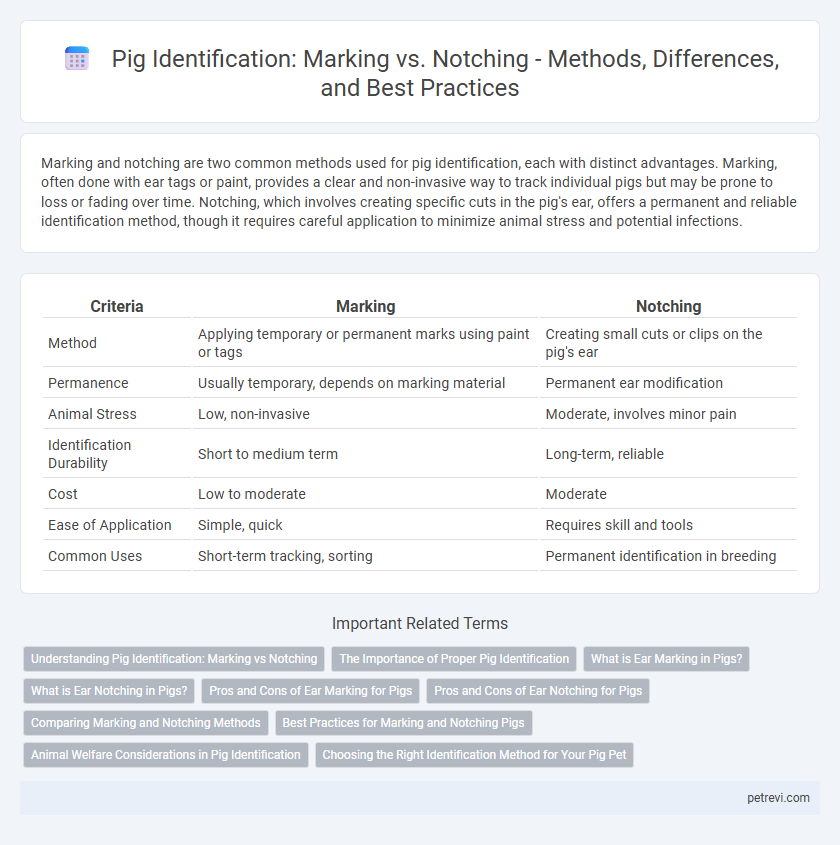Marking and notching are two common methods used for pig identification, each with distinct advantages. Marking, often done with ear tags or paint, provides a clear and non-invasive way to track individual pigs but may be prone to loss or fading over time. Notching, which involves creating specific cuts in the pig's ear, offers a permanent and reliable identification method, though it requires careful application to minimize animal stress and potential infections.
Table of Comparison
| Criteria | Marking | Notching |
|---|---|---|
| Method | Applying temporary or permanent marks using paint or tags | Creating small cuts or clips on the pig's ear |
| Permanence | Usually temporary, depends on marking material | Permanent ear modification |
| Animal Stress | Low, non-invasive | Moderate, involves minor pain |
| Identification Durability | Short to medium term | Long-term, reliable |
| Cost | Low to moderate | Moderate |
| Ease of Application | Simple, quick | Requires skill and tools |
| Common Uses | Short-term tracking, sorting | Permanent identification in breeding |
Understanding Pig Identification: Marking vs Notching
Marking and notching are two common techniques for pig identification that serve different purposes in livestock management. Marking typically involves applying temporary or semi-permanent marks such as paint or tags that allow for quick visual identification, while notching refers to creating permanent cuts in the pig's ear for long-term identification. Understanding the advantages and limitations of each method helps farmers choose the best strategy to track pigs effectively, maintain herd records, and ensure animal welfare.
The Importance of Proper Pig Identification
Proper pig identification through marking or notching is crucial for traceability, health management, and breeding accuracy. Marking techniques such as ear tags or tattoos provide clear, tamper-resistant records while notching enables quick visual identification without specialized tools. Effective identification methods prevent errors in treatment and ensure compliance with regulatory standards in swine production.
What is Ear Marking in Pigs?
Ear marking in pigs involves creating visible, permanent cuts or notches on the ear to identify individual animals within a herd. This technique provides a clear and durable method for tracking pigs' lineage, health records, and ownership. Ear marking differs from ear notching by often using larger or uniquely shaped tags or cuts for easy recognition.
What is Ear Notching in Pigs?
Ear notching in pigs is a method of identification involving the systematic removal of small V-shaped sections from the edges of a pig's ear. Each notch corresponds to a specific number or code based on the pig's litter and individual number, allowing for easy tracking and record-keeping in swine management. This technique is preferred for its permanence, cost-effectiveness, and ease of application compared to other identification methods such as ear tagging or tattooing.
Pros and Cons of Ear Marking for Pigs
Ear marking for pig identification offers a clear and relatively simple method to visually distinguish individual animals within a herd, enhancing inventory management and breeding records. However, this technique may cause stress and discomfort to pigs during the marking process, and over time, marks can become less visible due to ear growth or damage, reducing long-term reliability. Unlike notching, ear marking poses a lower risk of infection but requires regular monitoring to ensure identification remains legible.
Pros and Cons of Ear Notching for Pigs
Ear notching for pig identification offers a permanent, cost-effective, and painless method, ensuring easy recognition and traceability throughout the pig's life. However, improper application can cause stress or infection, and it may be less visible in pigs with damaged or torn ears, impacting accuracy. Unlike marking, which can fade or be removed, ear notching provides a reliable long-term solution but requires skillful execution to minimize animal welfare concerns.
Comparing Marking and Notching Methods
Marking and notching are two primary methods used for pig identification, each with distinctive advantages and limitations. Marking involves applying temporary or permanent marks on the pig's body, such as paint or tags, offering an easy and non-invasive way to track animals in large herds. Notching, which entails making specific cuts in the pig's ear, provides a durable identification system that remains visible throughout the pig's life but requires careful handling to prevent infection.
Best Practices for Marking and Notching Pigs
Marking pigs using ear tags or tattoos provides clear, lasting identification while minimizing tissue damage and infection risks, making it a best practice for effective tracking and record-keeping. Notching, typically performed on pig ears, requires precise technique to avoid excessive bleeding and stress, with best practices emphasizing sterilized tools and prompt aftercare to ensure animal welfare. Consistent application of these methods helps maintain accurate herd management and supports biosecurity protocols in pig farming operations.
Animal Welfare Considerations in Pig Identification
Marking methods like ear tagging are less invasive than notching, reducing stress and injury risks in pigs during identification. Notching involves cutting notches in the ear, which can cause pain and increase infection susceptibility, negatively impacting animal welfare. Choosing humane identification methods, such as RFID tags or non-invasive markings, supports better health outcomes and ethical treatment in pig farming.
Choosing the Right Identification Method for Your Pig Pet
Marking and notching offer distinct advantages for pig identification, with marking providing a non-invasive, temporary option through dyes or paints, while notching involves permanently removing a small portion of the ear for lifelong recognition. Choosing the right method depends on factors such as the pig's age, temperament, and the need for long-term identification versus short-term visibility. Consideration of animal welfare and ease of identification in various environments ensures effective management and care for your pig pet.
Marking vs Notching for Pig Identification Infographic

 petrevi.com
petrevi.com